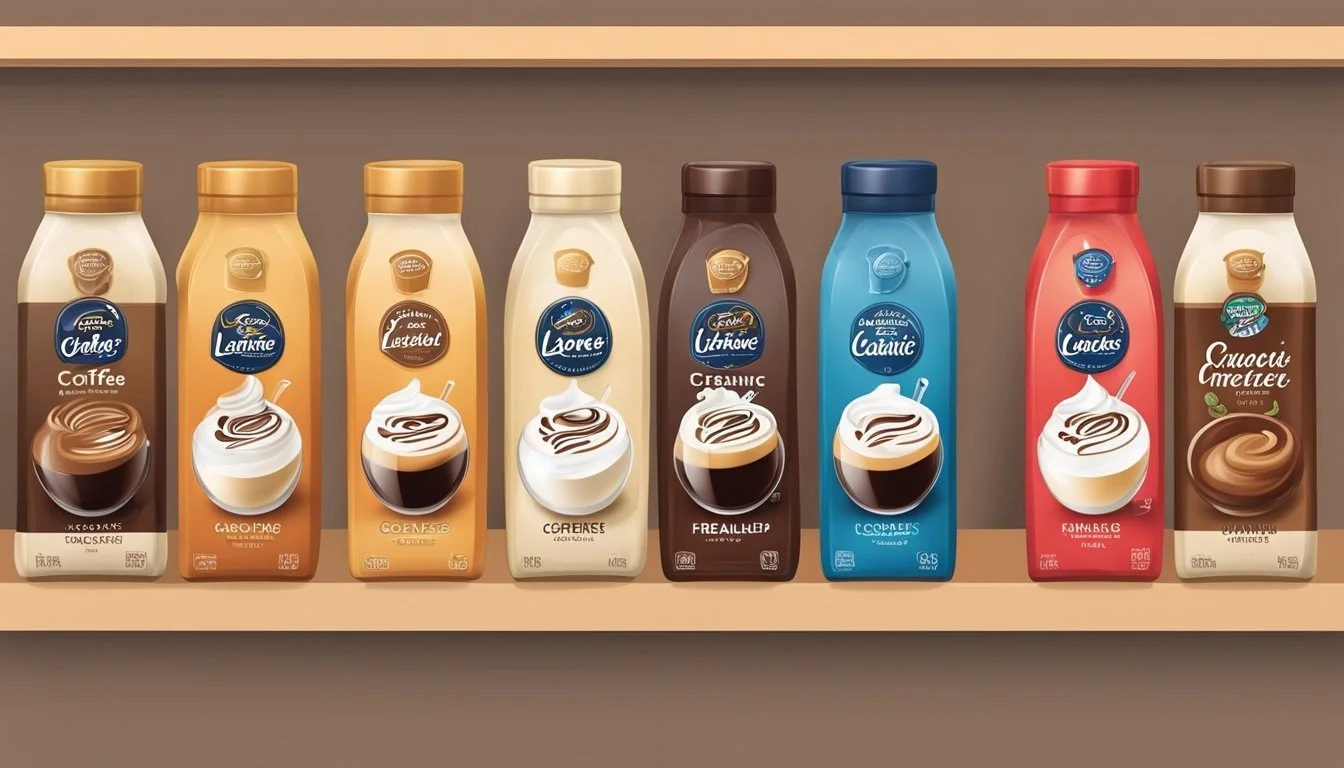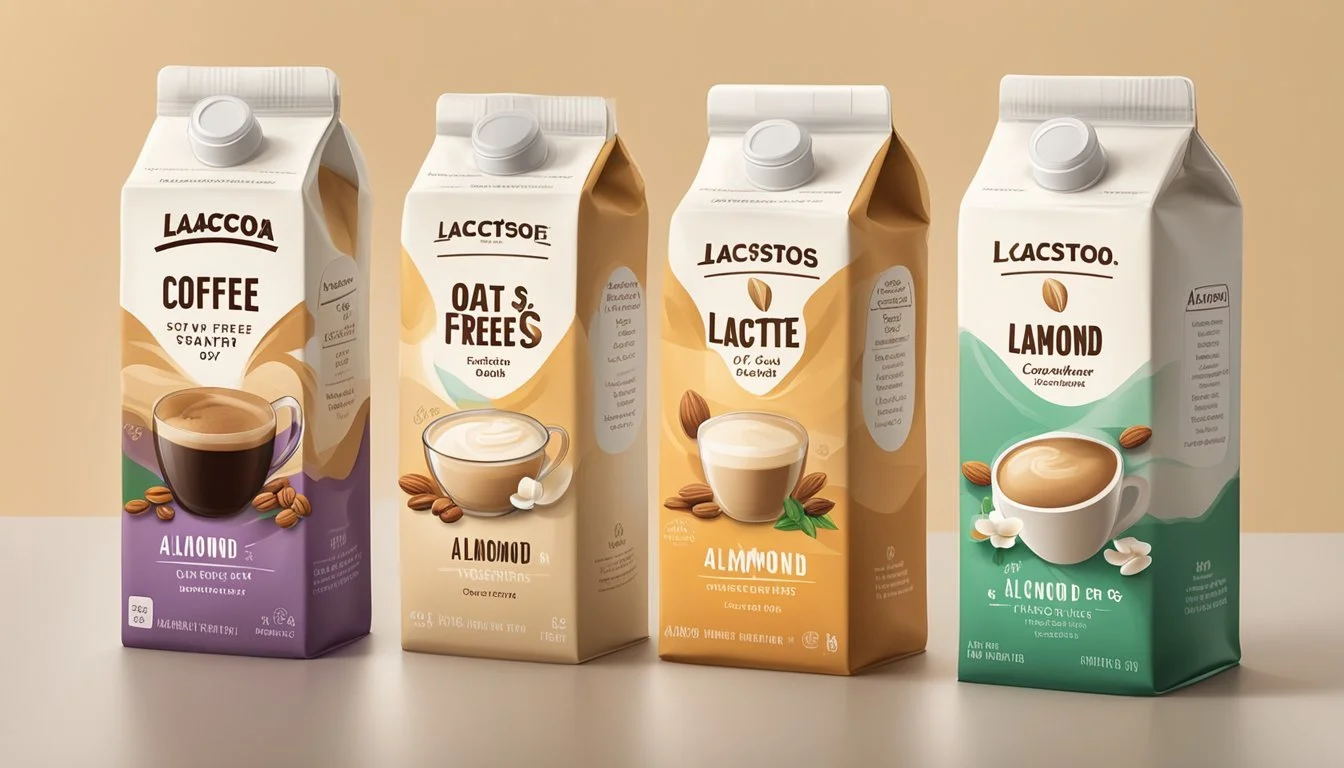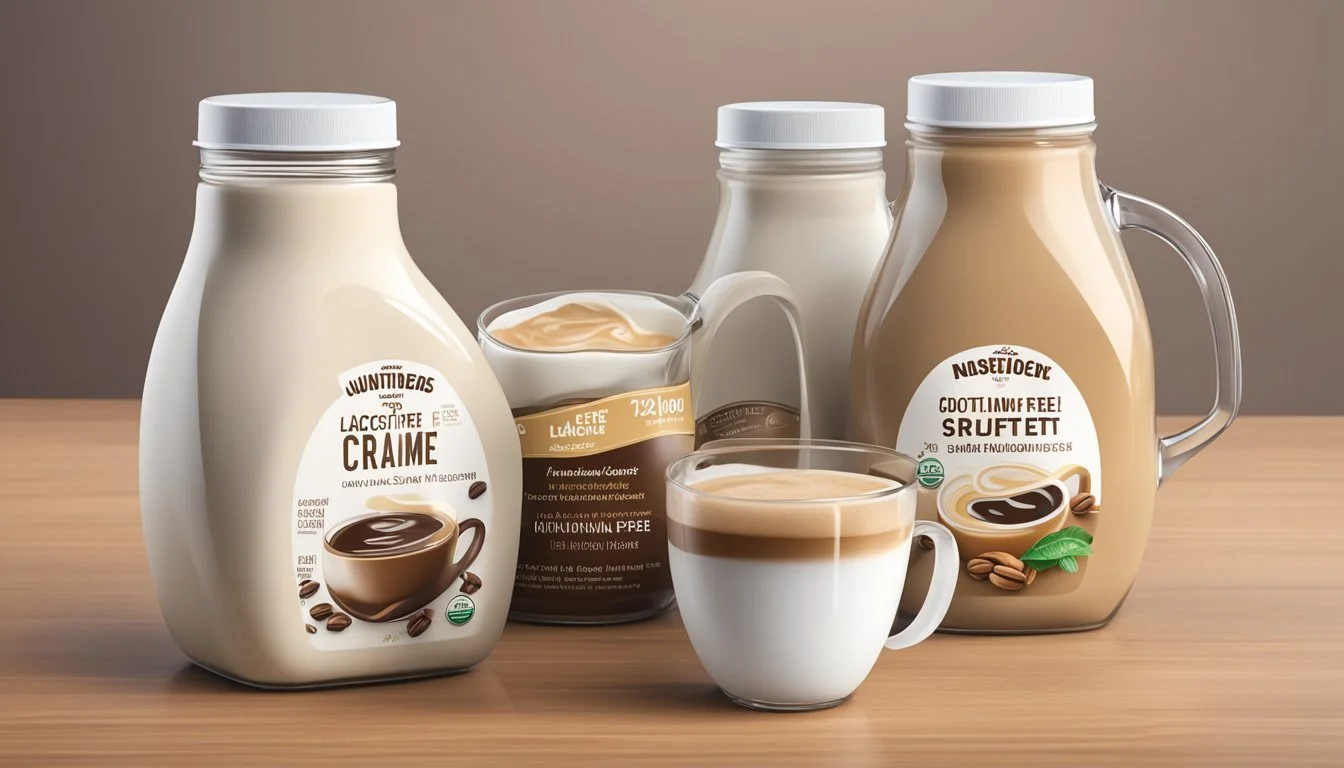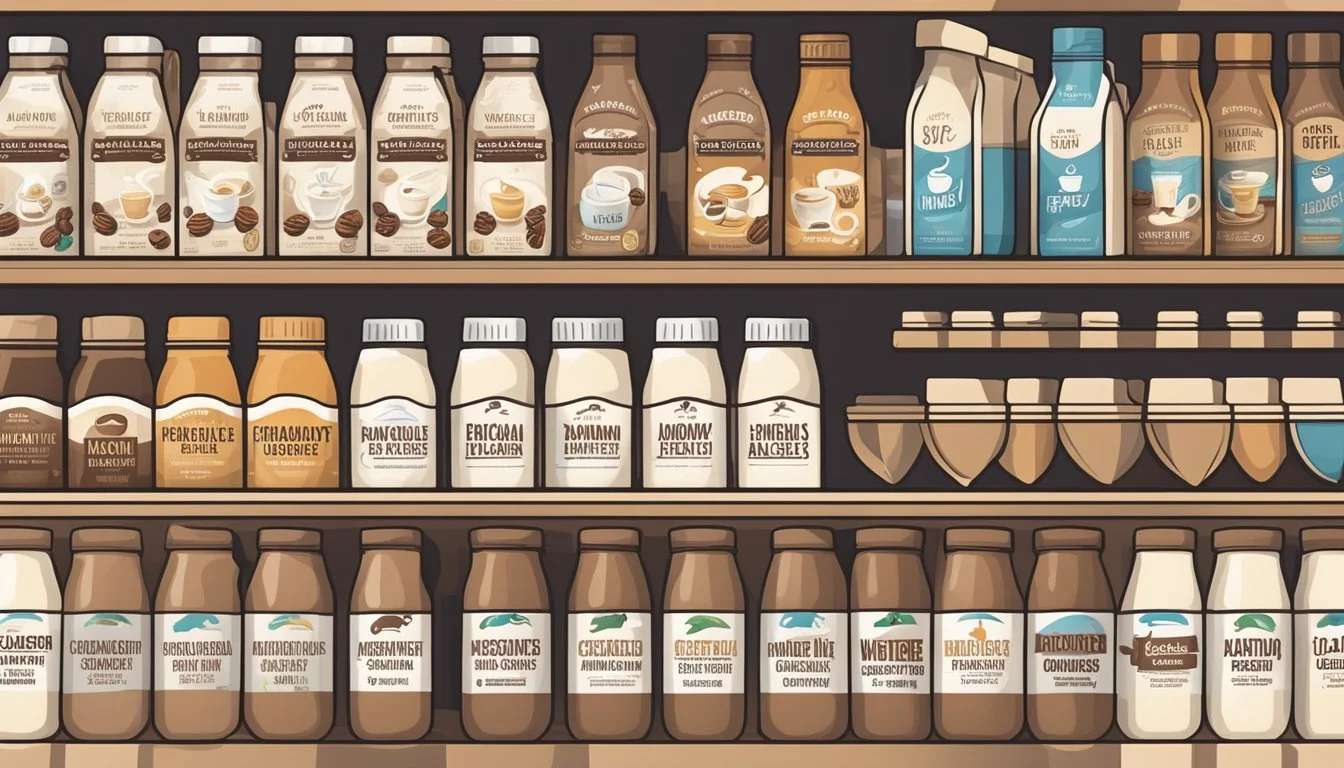What Are Some Lactose-Free Coffee Creamers?
Your Guide to Dairy-Free Options
Coffee enthusiasts with lactose intolerance or a preference for a dairy-free diet do not have to miss out on rich, creamy coffee. The market now offers a myriad of lactose-free coffee creamers that provide the same satisfying taste and texture as traditional dairy creamers without the lactose. These creamers are available in various forms, including liquid, powder, and flavored varieties, ensuring that there is an option for every palate and dietary need.
The most popular plant-based milks used to create dairy-free creamers include almond milk, coconut milk, oat milk, and soy milk. Each type boasts distinctive qualities and health benefits. Almond milk, for example, is appreciated for its low caloric content and absence of lactose or cholesterol, making it a heart-healthy alternative. Coconut milk offers a rich, tropical flavor with a creaminess that closely mimics dairy, while oat milk is celebrated for its environmental sustainability and its naturally sweet, mild flavor which complements coffee well. Soy milk, a long-standing favorite, provides a high-protein creamer option with a neutral taste.
Choosing the right non-dairy creamer is a matter of personal preference, dietary restrictions, and nutritional goals. For those looking for unsweetened options, products like Nutpods offer a full-bodied creaminess without added sugars, blending smoothly without separating in the coffee. Lactose-free creamers can not only match the textural qualities of traditional dairy but also come with the added advantage of diverse flavors and health benefits catering to the needs and tastes of coffee lovers everywhere.
Understanding Lactose Intolerance
Lactose intolerance affects many people worldwide, precipitating a need for lactose-free alternatives in their diets. Individuals with this condition struggle to digest lactose, a sugar found in milk and dairy products.
Lactose Intolerance Basics
Lactose intolerance is a digestive issue where the body lacks sufficient amounts of lactase, an enzyme needed to break down lactose. This sugar component is prevalent in dairy products, including milk, cheese, and yogurt. When lactose moves through the colon without being properly digested, it can cause symptoms like bloating, gas, and abdominal pain. There are different levels of lactose intolerance; some people might handle small amounts of lactose, while others cannot tolerate any.
Although often confused, it's important to distinguish lactose intolerance from a milk allergy. A milk allergy involves the immune system reacting against milk proteins and can potentially be life-threatening, while lactose intolerance is generally less severe and involves the digestive system.
Importance of Lactose-Free Options
For those who are lactose intolerant, consuming lactose-free products is essential to avoid discomfort. Lactose-free options enable individuals to enjoy products similar to dairy without adverse symptoms. This is particularly important for nutrient intake, as dairy products are rich in calcium and vitamin D. Lactose-free alternatives often come from plant-based sources such as almond, coconut, oat, and soy milk, which are engineered to mimic the taste and texture of dairy while providing necessary nutrients without the lactose.
Types of Non-Dairy Coffee Creamers
With a variety of plant-based ingredients, lactose-free creamers cater to diverse dietary preferences while providing unique flavors and textures to enhance coffee without dairy.
Almond Milk Creamers
Almond milk creamers are a popular choice for a non-dairy addition to coffee. They are typically low in calories and provide a nutty flavor. They do not contain lactose or cholesterol, making them a favorable option for those managing their dietary intake. Brands like Nutpods combine almond and coconut milk for a creamy texture that blends well without separation.
Soy Milk Creamers
Soy milk creamers are widely available and are known for their creamy consistency that mimics traditional dairy creamers. Rich in proteins, they are an excellent dairy-free alternative for those who enjoy the texture of full-fat creamers. Soy milk creamers are versatile and come in both flavored and unflavored varieties.
Oat Milk Creamers
Oat milk creamers have gained attention for their naturally sweet flavor and rich, creamy texture. They can add a smooth consistency to coffee and are often preferred by those seeking a dairy-free creamer with a taste profile that complements their beverage without overpowering it. Oat milk is also celebrated for its environmental sustainability compared to other non-dairy alternatives.
Coconut Milk Creamers
Creamers made from coconut milk are known for their slightly tropical flavor and ability to impart a rich, silky texture to coffee. They are suitable for those looking for non-dairy creamers with a distinct taste and a composition that caters to a low carbohydrate lifestyle.
Cashew Milk Creamers
Cashew milk provides a creamy and rich flavor similar to traditional creamers. It is another lactose-free alternative that works well for those looking for a balance between subtle sweetness and a creamy texture. Cashew milk creamers can also offer a range of nutrients like magnesium and zinc.
Pea Protein Creamers
Pea protein creamers represent a newer category in the non-dairy sector, offering a high-protein, allergen-friendly alternative. They are distinguished by their ability to froth and add a creamy consistency to coffee, attracting consumers who prioritize protein intake and those with soy or nut allergies.
Popular Lactose-Free Creamer Brands
Lactose-free creamers offer a delightful way to enjoy coffee without the discomfort that dairy can cause to those with lactose intolerance. With a variety of bases such as almond, soy, and other plant milks, these creamers come in numerous flavors and styles to complement any cup of coffee.
Silk Creamers
Silk is a brand widely recognized for its plant-based products, including an assortment of almond milk creamers. Silk creamers are smooth and come in flavors that cater to different preferences, providing a creamy consistency without the use of dairy.
Nutpods
Nutpods stands out with its combination of almond and coconut, resulting in a rich and versatile creamer. These non-dairy creamers are lauded for their ability to integrate seamlessly into coffee, providing a taste and experience close to traditional half-and-half without any lactose.
Califia Farms Creamers
Califia Farms offers a range of almondmilk creamers that elevate coffee without overpowering it. Known for their natural ingredients, Califia Farms creamers bring a subtle sweetness and smooth texture that makes them a popular non-dairy alternative.
So Delicious Creamers
So Delicious is another favorite for those looking for non-dairy options. Their creamers, often made from organic coconut milk or other plant bases, add a lush and creamy texture to beverages. As a plant-based creamer, So Delicious provides a rich flavor profile suitable for various coffee drinks.
Ripple Foods
Lastly, Ripple Foods crafted a unique twist on the lactose-free creamer market using pea protein. This innovative approach results in creamers that are nutrient-rich and environmentally sustainable, providing a pleasant creaminess with a minimal ecological footprint.
Nutritional Information and Health Considerations
When selecting a lactose-free coffee creamer, it's important to consider its nutritional content and impact on health. These factors include the number of calories, the presence of additives, and potential allergens that may affect individuals with specific dietary needs.
Calorie Content and Weight Considerations
Lactose-free creamers vary widely in calorie content. For those monitoring their weight, it's crucial to check the nutritional label. Almond milk creamers, for example, are typically low in calories, while those with coconut milk may be higher due to the natural fats present. An average serving size of these non-dairy creamers might look like this:
Almond milk creamer: 10-15 calories per tablespoon
Coconut milk creamer: 20-25 calories per tablespoon
High-calorie content, particularly from saturated fat, can contribute to weight gain if consumed excessively. Conversely, choosing a low-calorie creamer can be a healthier decision for those concerned with calorie intake.
Presence of Additives and Preservatives
Consumers often seek products with minimal additives or preservatives for health reasons. Some non-dairy creamers contain additives to enhance flavor, extend shelf life, or improve texture, such as gellan gum or potassium phosphate. On the other hand, an organic creamer may offer a clean label alternative, free from synthetic additives. Analysis of labels is essential for those who prefer gmo-free or minimum preservatives in their food and beverages.
Allergens and Dietary Restrictions
Apart from lactose, non-dairy creamers can contain other allergens like nuts or soy, which are crucial to identify for individuals with allergies. For instance:
Almond milk creamers: contain tree nuts
Soy milk creamers: contain soy
Moreover, those adhering to certain dietary practices should look for labels indicating the product is gluten-free or suitable for vegans. Ingredients derived from vegetable oil can also be found in certain creamers, which again, for some people, might be a point of consideration for both health and dietary guidelines.
Flavor Profiles
Lactose-free coffee creamers cater to a variety of taste preferences, offering everything from comforting classics to innovative seasonal delights. They often incorporate familiar flavors, with options to satisfy those looking for natural sweetness or spice-infused varieties.
Classic Flavors
Lactose-free creamers often start with classic flavors like vanilla and French vanilla. They're staples in the non-dairy creamer market for their smooth, sweet profiles that blend well with coffee. Sugar or natural sweeteners are typically used to enhance these flavors, providing a familiar taste without lactose.
Vanilla: A versatile and beloved option, which typically uses natural vanilla extracts for a rich flavor.
French Vanilla: Richer and creamier with a more pronounced vanilla scent, often featuring custard-like notes.
Seasonal and Specialty Flavors
Seasonal and specialty flavors introduce novelty and cater to diverse palates, with spiced and festive variations appearing throughout the year. They frequently include flavors like cinnamon during autumn or peppermint for the winter season. These creamers may use natural extracts or flavors to achieve the desired taste without lactose.
Cinnamon: A warm and inviting option, perfect for cooler months or those who enjoy a hint of spice.
Natural Vanilla: For the purist seeking a more authentic and less processed flavor profile, without additional sweeteners.
Making the Choice
When selecting a lactose-free coffee creamer, the sensory experience and individual preferences play crucial roles. Various creamers offer unique flavor profiles and health considerations that cater to different tastes and dietary needs.
Taste Test Reviews
Lactose-free coffee creamers have been scrutinized through numerous taste tests to examine their flavor and how well they blend with coffee. Coconut milk creamers are praised for their creamy texture, with a subtle hint of tropical sweetness. Almond milk creamers, on the other hand, provide a nuttier undertone and are typically lighter in consistency. Oat milk creamers have gained popularity for their smoothness and ability to mimic the velvety mouthfeel of traditional dairy creamers. Soymilk-based creamers are esteemed for their neutral taste, although some variants offer vanilla or chocolate accents.
Creamer Base Flavor Notes Texture Coconut Milk Tropical sweetness Creamy Almond Milk Nutty undertone Light Oat Milk Naturally sweet Velvety Soy Milk Neutral to flavored Variable
These reviews guide consumers to find what matches their cravings and coffee profiles best, considering whether they prefer something close to traditional creamers or a distinctive alternative taste.
Consumer Preferences
Consumer preferences are diverse and vary widely, but they tend to converge on certain attributes such as health benefits and ingredient transparency. Many lactose-intolerant individuals seek creamers that are not only free from lactose but also low in saturated fats and artificial additives. On the contrary, some consumers prioritize indulgence over calorie content, opting for creamers that satisfy their sweet tooth without regard to sugar content.
Preferences also depend on dietary restrictions and lifestyle choices, including veganism or a clean-eating regimen, which might drive consumers towards creamers made with organic ingredients. These inclinations shape the demand in the market, with more companies offering a broad range of products to accommodate the varied tastes and health considerations of lactose-intolerant coffee drinkers.
How to Use Lactose-Free Creamers
Lactose-free creamers can be a health-conscious choice for individuals with lactose intolerance or those following a dairy-free diet. These creamers are versatile and can be used much like traditional dairy creamers.
To Serve: Lactose-free creamers are typically portioned similarly to dairy-based creamers. One tablespoon per cup of coffee is common, but users can adjust the serving size to suit personal taste. They should pour the creamer into the cup first, followed by the coffee, to allow it to mix thoroughly without the need for excessive stirring.
Storage Tips: These creamers should be stored according to the manufacturer's instructions, with most liquid creamers requiring refrigeration after opening. Powdered versions, however, can be kept in a cool, dry location.
In Recipes: For those looking to explore beyond coffee, lactose-free creamers can be incorporated into recipes. They serve well as a dairy substitute in various dishes and desserts, offering a creamy consistency without the lactose. When using in recipes, it's important to consider the flavor profile of the creamer chosen, as some are flavored and may alter the taste of the dish.
Sweet Applications: They can be added to sweet recipes like mousses, puddings, or pastries.
Savory Dishes: Unsweetened and unflavored creamers can be used in soups or sauces as a thickening agent.
Lactose-free creamers come in an array of flavors and bases, such as almond, coconut, oat, and soy milk. Individuals should select a creamer that aligns with their nutritional needs and flavor preferences. It’s equally important to shake liquid creamers well before each use to ensure the product is well-mixed and delivers the creamy texture consumers enjoy.
Environmental and Ethical Considerations
In the context of lactose-free coffee creamers, the impact on the environment and adherence to ethical practices can’t be overlooked. Ingredients' sourcing and the production process both play significant roles in the broader implications of creamer consumption.
Plant-Based and Vegan Considerations
The proliferation of plant-based lactose-free creamers mirrors a growing consumer interest in vegan options. These creamers offer an alternative to dairy without compromising on taste or texture. However, the environmental footprint of plant-based ingredients varies. For example, almond milk production is water-intensive, while oat milk generally has a lower water requirement. Consumers often look for products that align with their ethical standards, which includes considering the treatment of workers and the overall impact of farming practices on biodiversity and ecosystems.
Almond Milk: Requires significant water resources.
Oat Milk: Tends to have a lower environmental impact.
Soy Milk: Often genetically modified, raising concerns for some consumers.
Sourcing and Sustainability
Sustainable sourcing of ingredients is vital for reducing the ecological impacts of creamer production. Ethical sourcing policies focus on fair labor practices and environmentally friendly farming techniques. Brands that prioritize sustainability might use organic farming methods that avoid synthetic pesticides and fertilizers, thus reducing soil and water contamination. They might also engage in direct trade practices, ensuring farmers receive fair compensation and fostering community development.
Organic Farming: Reduces the use of harmful chemicals.
Fair Trade: Assures fair working conditions and compensation.
Reforestation Efforts: Some companies invest in ecological restoration.
Product packaging also falls under this category, with brands increasingly moving towards biodegradable or recyclable materials to reduce waste.
Homemade Lactose-Free Creamer Options
For those seeking lactose-free alternatives to traditional coffee creamers, homemade versions provide control over ingredients, allowing for a natural and potentially organic approach. A variety of recipes enable the creation of creamers tailored to personal taste preferences and dietary requirements.
Coconut Milk Creamer is a popular base for lactose-free creamers due to its rich, creamy texture. To make it, one simply combines equal parts of coconut milk with a natural sweetener like honey or agave syrup, adding a pinch of salt to enhance the flavor.
Almond Milk Creamer: Almond milk offers a nutty flavor and is lighter than coconut milk. Blend unsweetened almond milk with a sweetener and optional vanilla extract for a simple creamer. For added richness, a tablespoon of coconut oil or a natural plant-based oil can be incorporated.
Oat Milk Creamer: Oat milk has a naturally sweet and mild profile, making it ideal for creamy textures. By combining oat milk with dates or maple syrup, and a touch of vanilla, one achieves a delightful creamer that can complement various types of coffee.
Those interested in an organic creamer can ensure that all ingredients sourced are certified organic. A key tip is to strain homemade creamers for a silkier finish, utilizing a nut milk bag or a fine mesh strainer.
These homemade creamers not only avoid lactose but also exclude the preservatives and additives often found in commercial options. They can be refrigerated and typically maintain freshness for about a week. Experimenting with these recipes allows individuals to enjoy their coffee with a personalized touch, knowing exactly what's in their cup.
FAQs on Lactose-Free Creamers
What are lactose-free coffee creamers?
Lactose-free coffee creamers are alternatives to traditional dairy creamers, designed for individuals who are lactose intolerant. These creamers provide the creamy texture and flavor enhancement without the discomfort of lactose. They are often made from plant-based sources like almond, coconut, soy, or oat milks.
Can lactose-free creamers be considered healthy?
Nutrition experts advise that lactose-free creamers can be included as part of a balanced diet. However, the health value depends on the specific products and their ingredients. Some creamers may be high in added sugars or saturated fats, while others may be fortified with vitamins and minerals. The FDA recommends reading labels carefully to make informed choices.
What do dietitians say about lactose-free creamers?
Dietitians often recommend checking for added ingredients and nutritional content. Opting for unsweetened or naturally sweetened options with minimal additives is typically advised. Dietitians may also suggest using lactose-free milk as a creamer for a simpler and potentially healthier option.
Are there any research findings on lactose-free creamers?
While research is more extensive on dairy milk and its alternatives, studies on lactose-free creamers are limited. Existing research suggests that choosing plant-based creamers could be beneficial for those with lactose intolerance and those following a vegan diet.
Which lactose-free creamers are available on the market?
Nestle Coffee Mate: Offers lactose-free versions, including Natural Bliss line.
Califia Farms: Known for creamy, plant-based creamers.
Nutpods: Provides unsweetened, dairy-free creamer options.
So Delicious: Offers creamers made from coconut milk and other plant bases.
Ripple: Uses pea protein to create a lactose-free half-and-half alternative.
ECOS Coconut Creamer: A natural option made exclusively from coconuts.
Consumers should consider personal taste preferences and dietary needs when selecting a lactose-free creamer.








